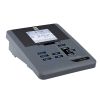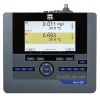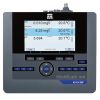YSI TruLine Nitrate Electrode
Features
- PVC membrane with replaceable module
- Double junction reference
- 0.4-62,000 mg/L range
- Free ground shipping
- Expedited repair and warranty service
- Lifetime technical support
- More
Overview
TruLine combination nitrate electrode features BNC connection and can be used with the YSI TruLab 1320. It can also be used with the YSI MultiLab 4010-2 or 4010-3 if a BNC adapter is installed.
TruLine Series
The TruLine series of laboratory ISEs consists of 15 electrodes that have an integrated reference, eliminating the need to have a separate reference half-cell. Each TruLine ISE has a refillable double-junction reference, resulting in a long electrode life and exceptional measurement reliability. TruLine ISEs can be connected to any ISE instrument featuring BNC connection, including the YSI 1320. Reference/electrode fill solution, ionic strength adjustor, and a small bottle of standard are included with each ISE.
Benefits
- Wide selection of 15 electrodes for 16 different parameters
- 4 sensor technologies - gas sensing, polymer/PVC membrane, solid state, and glass sensor
- Combination (i.e. full-cell), refillable electrodes with double-junction reference
- BNC connection, 1m cable
- Made in the U.S.A
- Reference/electrode fill solution, ionic strength adjustor, and small bottle of standard included with each ISE
- 12-month warranty for solid state, glass sensor, and gas-sensing ISEs
- 9-month warranty for ISEs with polymer/PVC membrane
- (1) Electrode with 1m cable
- (1) Small bottle of reference/electrode fill solution
- (1) Small bottle of ionic strength adjuster
- (1) Small bottle of standard solution
In The News
Monitoring Habitat Suitability and Water Quality in Northwest Arkansas Springs
Northwest Arkansas has seen an economic, industrial, and population boom in recent years as a result of expanding businesses, which have created thousands of jobs in the region and the mass migration of employees and construction companies. However, with this growth has come rapid urbanization and the degradation of the natural landscape, specifically the freshwater springs that can be found throughout the region. These springs are critical habitat centers for native wildlife, home to threatened and endangered fish, and those that have yet to be listed. Zach Moran, Assistant Professor of Fisheries Science at Arkansas Technical University, is working to help monitor these habitats and provide key data that will hopefully inform future development in the region.
Read MoreThree Decades of Research at Acton Lake
A multi-disciplinary team at Miami University, Ohio, has been studying the environmental change at Acton Lake for over three decades. Using three different NexSens buoys over this time, the team has an incredible archive of data that is helping build a picture of Acton’s past, present, and future. Until recently, a NexSens CB-50 buoy was used alongside other environmental monitoring at Acton Lake. In May 2025, the Miami team deployed a new XB-200 buoy , future-proofing their ongoing monitoring using real-time buoy systems. Acton Lake, a small hypereutrophic reservoir in southwest Ohio, covers 2.4km² and has a maximum depth of about 8m. The dam was built in 1956, and the lake has a large agricultural watershed.
Read MoreSource Water Monitoring in Albany, New York: Tracing Water Quality throughout Tributaries
Thousands of US cities pull their drinking water from natural source waters like reservoirs, rivers, and streams, making overall watershed health a key consideration for water providers. In Albany, New York, the Albany Department of Water and Water Supply delivers drinking water to over 100,000 residents as well as monitors and manages the larger drinking water supply watershed. Hannah Doherty, Environmental Specialist at the Albany Department of Water and Water Supply , spends her days working with a small team to monitor the drinking supply and the connected water bodies. Doherty explains, “We’re the first to encounter the water that ends up being the drinking water.
Read More














